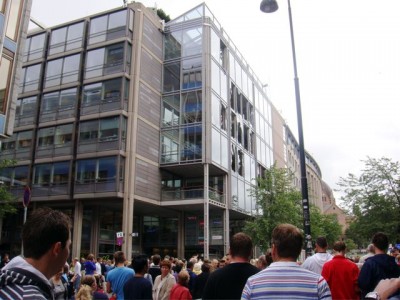The flags were still flying at half-mast and a few helicopters still whirred overhead, but Norwegians took to the streets of their capital on Monday and made it clear Oslo wasn’t in the hands of any terrorists. They held tributes to the victims of a lone gunman and bomber on Friday, quietly surveyed damage from his attacks and simply seemed to shake off fear and reclaim the city.

Large crowds of people, young and old, filled the streets, especially the streets that brought them as close as they could get to the badly damaged government complex in the heart of town and near the Oslo Cathedral, where a huge mound of flowers, flags and candles kept growing.
Many people were carrying flowers as they walked through downtown, and there were lines at several florists near the cathedral, where a memorial service was held on Sunday. The crowds were just as large on Monday, and the doors of the cathedral remained open for those seeking quiet reflection over the attacks that stunned this otherwise relatively peaceful corner of the world.

Police and government officials, who had warned Norwegians to stay out of downtown Friday night and early Saturday, just after the attacks, started urging people to come back to town later in the weekend. They are intent on maintaining Norway’s traditionally open society, where security barriers are kept to a minimum and the electorate enjoys easy access to political leaders. Justice Minister Knut Storberget has said repeatedly that Norwegians must not let the actions of terrorists or Friday’s gunman, a right-wing extremist named Anders Behring Breivik, destroy their culture of accessibility.

Monday’s heightened activity in Oslo was highlighted by another memorial ceremony at the University of Oslo’s Aula, a richly decorated auditorium once used as the site of the Nobel Peace Prize ceremonies. Prime Minister Jens Stoltenberg, who has held a high profile throughout the crisis despite suffering personal grief over the loss of many Labour Party colleagues in the attacks, stood outside the Aula next to King Harald, other members of the royal family and fellow government ministers to observe a moment of silence as the clock struck noon.
A large crowd had filled the plaza in front of the Aula, which featured flaming torches under leaden skies and a flag at half-mast. Many had their arms around one another as the city came to a standstill.
When the country’s leaders went inside, the crowd disbursed and many headed down Oslo’s main boulevard called Karl Johans Gate towards the site of Friday’s bombing. Clean-up efforts are already underway but some government ministers have conceded that the buildings including the high-rise housing Stoltenberg’s own office may need to be razed. As glass specialists worked to replace shattered windows in nearby shops, spectators stared at the blown-out windows in the Finance Ministry and Supreme Court buildings, as if trying to comprehend the enormity of Friday’s attack.
Others gathered in the large public square known as Youngstorget, which is surrounded by the offices of Norway’s trade union confederation and several political party headquarters including Labour (Arbeiderpartiet), which was a target of Friday’s attack that left at least 86 young party members dead. Voices were low and the mood somber, but one woman seemed to sum up the situation by quietly gesturing to her son and telling him “dette skal sikkert bygges up igjen.” In short: This will surely be rebuilt.
Views and News from Norway/Nina Berglund
Join our Readers’ Forum or comment below.
To support our news service, please click the “Donate” button now.

